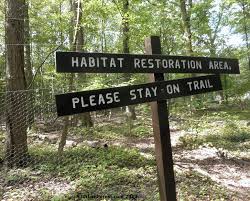Church Habitat Restoration 101
Part of an ongoing series on best practices for Creation Justice Churches
A church can become revitalized by connecting with God’s creation. This revitalization can be as easy as stepping outside the doors of your church to care for the land and natural habitat surrounding it. An important act of creation care that many churches can take today is habitat restoration. Because this can be a new concept for many church goers, this primer helps introduce the practice:
 What is habitat restoration?
What is habitat restoration?
In a broad sense, habitat restoration is returning the living spaces of plants and animals to their condition as it was before civilization. It does not require removing all human structures, however. To the contrary, plants and animals can live quite well with humans if we restore the food and shelter they require, i.e., native plants.
Why is habitat restoration needed?
The survival of our entire food chain depends upon the habitats provided for even the smallest of God’s creatures. We know that insects are at the beginning of the food chain and humans are at the end. If insects disappear, this entire chain is jeopardized. Present dangers to our interconnection are substantial. We stand to lose half our plant and animal species by 2100, one-quarter by 2050, if we continue to destroy wildlife habitat at the present rate. Native insects can eat only native plants, not foreign plants which are taking over. A high percentage of wildlife depends on insects for life, and most birds cannot propagate without insects. We can forestall this disaster only if we remove enough foreign plant species and replace them with native plants.
Why are churches especially important to this work?
Suburbia, including green spaces in or near cities, is the last remaining space for restoring habitat after losing the rest of our space to agriculture and cities. Even our wildlife preserves and national parks are not big enough to provide all of the habitat needed. Because churches own properties throughout suburbia, they can not only undertake habitat restoration projects but also become role models and educational centers for the work of restoration. Even churches without their own property can educate their members and community.
How can a church get started?
Educate your congregation about habitat restoration. They need to buy into the vision so that changes can be made to the church’s landscape, requests for funding can be granted, and volunteers contribute to the work to be done on the grounds. To help with learning about habitat restoration, reading groups can be formed to read Douglas Tallamy’s Bringing Nature Home. Guest speakers can be invited from the local soil and water conservation district, Audubon, and other habitat restoration specialists. Conduct education as far in advance of first season planting as possible. Urge current grounds maintenance volunteers to participate so they will be on board when you get started.
After the initial education is done, form a habitat restoration team to plan and implement the work to be done. Include as many as possible in decisions concerning plant purchases and planting locations. Bring a spirit of fellowship to your work so that there is time for breaks, social gathering, and a drop-in visit by the clergy. Hold daytime meetings when possible to facilitate viewing the grounds.
In planning your first season, learn to identify the plants on your church property, including which ones are native and which are alien. Get plant identification guides from local organizations. Learn about area native plant nurseries, visit them and see their plants. Learn about grant availability and procedures from local experts. Consult an expert about your plan. Consider whether you need a habitat restoration contractor for heavy or specialized work. Determine the best planting season. Discuss your plan with appropriate church staff so that you can discuss concerns related to water, facilities, and church schedule coordination.
The Rev. Jim Ruyle is a member of Hillsdale Community Church in Portland, Oregon. After leading the habitat restoration of his own church, Ruyle now leads and teaches habitat restoration for churches in the Portland area.
Related News
Can a Small Church Make a Difference on Environmental Justice? Yes!
American anthropologist Margaret Mead once observed, “Never doubt that a small group of...
Read MoreChurch Launches Community Composting Opportunity
Coral Isles Church in Tavernier, Florida recently kicked off a community composting...
Read MorePostcards for the Planet: Engaging Environmental Voters This Election Season
During this election season, the Green Christians at the Coral Gables United Church of...
Read More
